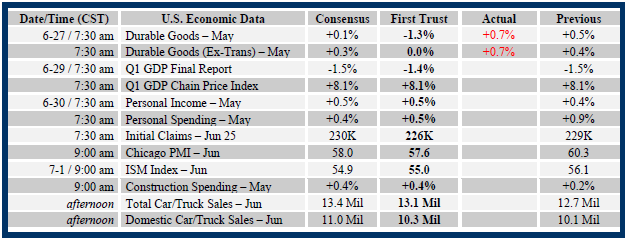First Trust Monday Morning Outlook
Brian S. Wesbury – Chief Economist
Robert Stein, CFA – Dep. Chief Economist
Strider Elass – Senior Economist
Andrew Opdyke, CFA – Senior Economist
Bryce Gill – Economist
Real GDP declined at a 1.5% annual rate in the first quarter and, as of Friday, the Atlanta Fed’s “GDP Now” model projects zero growth in Q2.
We still think real GDP will turn out to be positive in the second quarter, but if you take the Atlanta GDP Now model at face value, it superficially appears that the odds of having two consecutive quarters of negative growth are close to 50%. That’s important, because two consecutive quarters of negative growth is a rule of thumb that many people use for a recession.
We believe a recession is coming but the US is clearly not in one yet. In the first five months of the year, manufacturing production is up at a 6.6% annual rate, nonfarm payrolls are up at an average monthly pace of 488,000, and the unemployment rate has dropped to 3.6% from 3.9%. Meanwhile, in April, both “real” (inflation adjusted) consumer spending and real personal income (Excluding transfers) were at record highs. If this is a recession, we could use more recessions.
It’s also important to recognize that real gross domestic income (real GDI), an alternative measure of economic output, rose at a 2.1% annual rate in the first quarter. The public pays very little attention to GDI because the government usually takes an additional month to report that data, after GDP is initially released. But, over time, GDI is just as accurate as GDP in describing the performance of the economy.
We’re not saying everything is fine with the US economy. Obviously, inflation is taking a huge bite out of people’s earnings. But the debate about whether we’re in a recession should be about real economic pain, not academic-style semantics or whether we fit some technical definition. That’s the reason the official arbiter of recessions, the National Bureau of Economic Research, weighs jobs, manufacturing, and real incomes, when assessing whether we’re in a recession, not just real GDP.
We suspect that some of this debate is political, with some champing at the bit to claim there’s a recession because they know it hurts the party of the incumbent president in a mid-term election year.
Again, we expect a recession, with a lag, after monetary policy gets tight. And tight it must get in order to wrestle inflation back down toward the Federal Reserve’s 2.0% target. But that means a recession starting in late 2023 or in 2024, not now.
Even more unlikely is the notion that the US is on the cutting edge of a recession like the one in 2008-09. Bank capital is well above regulatory requirements and we don’t have a mark-to-market accounting rule that will generate a “Fire sale” in bank assets. Nor are we about to have a government lockdown of the private sector, like in 2020.
When it comes, the recession will cause economic pain for many. Recessions always do. But we expect something like the recessions in 1990-91 or 2001, when the unemployment rate went up about 2.0 to 2.5 percentage points, not like the soaring unemployment of the Great Recession or the 2020 Lockdown.
The attached information was developed by First Trust, an independent third party. The opinions are of the listed authors at First Trust Advisors L.P, and are independent from and not necessarily those of RJFS or Raymond James. All investments are subject to risk. There is no guarantee that these statements, opinions, or forecasts provided in the attached article will prove to be correct. Individual investor's results will vary. Past performance does not guarantee future results. Forward looking data is subject to change at any time and there is no assurance that projections will be realized. Any information provided is for informational purposes only and does not constitute a recommendation. Investing involves risk and you may incur a profit or loss regardless of strategy selected.

